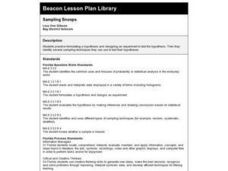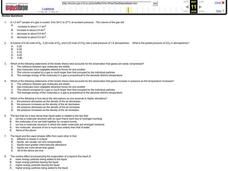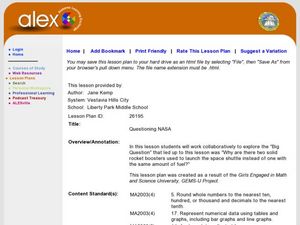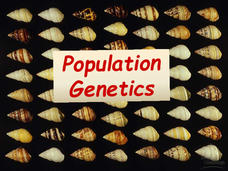Discovery Education
Fuss About Dust
Dust is everywhere around us; it's unavoidable. But what exactly is dust and are certain locations dustier than others? These are the questions students try to answer in an interesting scientific investigation. Working independently or...
Learning Games Lab
Bacteria Sampling
Scholars explore the procedure for bacteria sampling in a virtual lab by first walking through a detailed step-by-step procedure of preparing the samples of raw milk and pasteurized milk, growing the bacteria, and comparing results....
Houghton Mifflin Harcourt
Random Samples: Estimating Population
With this estimating populations assignment, your class will learn about taking random population samples and calculating the average number of species in the samples to estimate the total population. Students use the given data to find...
Curated OER
Sampling Snoops
Students practice formulating a hypothesis and designing an experiment to test the hypothesis. They identify several sampling techniques they can use to test their hypotheses.
Curated OER
Hypothesis Testing: Two Sample Tests
Young scholars experiment and compare results of two populations. In this men and women populations lesson, students examine the difference in hand span for men and women. Young scholars calculate a norm based on their results. Students...
NOAA
Sustaining Our Ocean Resources
Lead young scientists on an investigation of fishery practices with the final installment of this four-part unit. Using a PowerPoint presentation and hands-on simulation, this lesson engages children in learning how fish populations are...
Curated OER
Hardy-Weinberg Problems Tutorial
High schoolers are tested on their ability to solve mathematical problems dealing with the Hardy-Weinberg principle. There are 7 basic types of Hardy-Weinberg Problems which are randomly chosen by the program. Students sit at the...
Curated OER
Annual Wetland Plant Diversity Survey
High schoolers locate an area of marsh and, by measuring the total number of individual plants in a sample area, determine whether purple loosestrife population density is correlated to the total plant diversity of the community. They...
Curated OER
Phases of Matter
For this matter worksheet, learners calculate volume and partial pressure for gases, compare liquid and vapor phases, and review the characteristics properties of gases. This worksheet has 12 multiple choice and 3 problems to solve.
Curated OER
Star Cluster Math
In this star cluster math activity, students use four different patterns to solve five problems about the fraction of stars classified by their temperature.
Curated OER
Who Is It?/Who Done It?
Students conduct an experiment that allows them to assess individual differences in random DNA sequences and apply those differences when solving a forensic problem. After discussing the polymerase chain reaction and its use to identify...
Normal Community High School
Scientific Measurement
Pupils learn everything from how to take scientific measurements, to accuracy/precision, to density and a plethora of topics from a presentation on the metric system.
Curated OER
CATCH, TAG and RELEASE
Students apply estimation strategies for problem-solving purposes. They become familiar with one aspect of a marine biologist's work.
Curated OER
DNA Fingerprinting with Gel Electrophoresis
Learners use DNA fingerprinting to demonstrate the concept that DNA fingerprinting can be used to identify individuals and solve problems. They use gel electrophoresis to analyze the DNA of a suspected criminal to prove innocence or guilt.
Curated OER
Invasion of the Habitat Snatchers!
Fourth graders investigate invasive plants found in a park or school environment and acknowledge the problems caused by the plants. They describe 4 methods of control of invasive plants.
Curated OER
Questioning NASA
Space science and math collide in this inquiry that investigates launching times for antacid-tablet rockets! Upper elementary or middle school learners collect data as they launch these mini rockets. They apply concepts of place value...
Curated OER
Midnight Dumpers
Learners explain how pollution affects ground water. They participate in a simulation to discover the location of an illegal dump. Students explore the monetary benefits, risk and environmental concerns are factors in business decisions.
Biology Junction
Population Genetics
Genetic variation shows the health of a population, yet cheetahs show very little variation over that last 10,000 years. Scholars learn the importance of genetic variation in populations after viewing an informative presentation. It...
Curated OER
Home Sweet Home
Students examine the change in the diversity of animals living in an area before and after development. In order to do this, students need to have access to an area near their school which is undeveloped. A good, "real life" lesson.
Curated OER
The Big Bang-Hubble's Law
For this Hubble's law worksheet, students use data for galaxies which include their distance and speed. Students make a graph to show the distance to each galaxy and the speed of each galaxy. They use their graph to answer 4 questions...
Curated OER
Insect Classification
Pupils compare and contrast the visible structures of three insects based on photographs. They differentiate characteristics of crane flies, ants, and wasps then create a simple classification system.






















